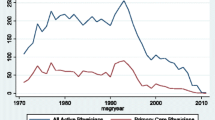Abstract
As healthcare systems around the world are facing increasing physician shortages, more physicians are migrating from low to high income countries. Differences in medical education and international interaction may have significant effect on physician flows. The Chinese Medical Graduates (CMGs) in the US present an interesting case to examine this effect. This paper evaluated the current number and historical trends of CMGs in the US from mainland China, Taiwan, and Hong Kong comparing their differences and similarities in terms of demographic and geographic characteristics. Since 2000, the number of CMGs in the US showed a consistent upward trend at a rate of approximately 206 additional graduates per year. In 2010, there were 8,797 CMGs in the US. Compared to CMGs from mainland China, CMGs from Taiwan and Hong Kong were much older. Much larger proportion of Taiwan and Hong Kong CMGs were male. However, they were more likely to practice in solo settings than mainland CMGs. The vast majority of CMGs are concentrated in urban areas and no significant differences were found for their distributions in underserved areas. However, a larger proportion of Taiwan and Hong Kong CMGs were in western coastal states; whereas a larger proportion of mainland CMGs were located in eastern coastal states. Fluctuations in CMG numbers in the US reflect the significant differences within the medical education systems among the three. The seemingly homogenous CMGs in the US do show significant differences. Given the magnitude and historical trends of migration of CMGs to the US, further exploration of its causes and impact is needed.








Similar content being viewed by others
References
Akl, E. A., Maroun, N., Najor, S., Chahoud, B., & Schunemann, H. J. (2007). Graduates of Lebanese medical schools in the United States: An observational study of international migration of physicians. BMC Health Services Research, 7, 49.
BBC Monitoring Asia Pacific—Political Supplied by BBC Worldwide Monitoring (2009, March 25).
China Daily (2006, April, 8). Medical brain drain hurts poor nations.
China Daily (2006, November, 23). Medical feat Indian doctors, made in China.
China Post (2011, February, 9). Young doctors not choosing obstetrics group.
Cooper, R. A. (2004). Weighing the evidence for expanding physician supply. Annals of Internal Medicine, 141(9), 705–714.
Cooper, R. A. (2007). It’s time to address the problem of physician shortages: Graduate Medical Education is the key. Annals of Surgery, 246(4), 527–534.
Deng, Y. (1990). Development of medical education in China. Academic Medicine, 65(8), 512–514.
Dill, M. and Salsberg, E.S. (2008) The complexities of physician supply and demand: Projections through 2025. Association of American Medical Colleges, Center for Workforce Studies.
Hart, L. G., Skillman, S. M., Fordyce, M., Thompson, M., Hagopian, A., & Konrad, T. R. (2007). International Medical Graduate physicians in the United States: Changes since 1981. Health Affairs, 26(4), 1159–1169.
Huang, J. S. (1992). Medical education and medical education research and development activities in modern China. Medical Education, 26(4), 333–339.
Kletke, P. R. (2004). Physician workforce data: When the best is not good enough. Health Services Research, 39(5), 1251–1256.
Kuan, P. (1970). Medical education in Taiwan. Medical Education, 4(2), 164–167.
Lam, T. P., Wan, X. H., & Ip, M. S. M. (2006). Current perspectives on medical education in China. Medical Education, 40(10), 940–949.
Lee, M.-H. (2008). Three essays on economic reform and household behavior in contemporary China, Doctoral Dissertation. Boston University.
Lee, S. H., & Lee, J. C. K. (1997). Mainland China, Taiwan and the Hong Kong Region: the Second Medical Education Conference. Medical Education, 31(6), 468–472.
Mejia, A. (1978). Migration of physicians and nurses: A world-wide picture. International Journal of Epidemiology, 7(3), 207–215.
Mullan, F. (2005). The metrics of the physician brain drain. New England Journal of Medicine, 353(17), 1810–1818.
South China Morning Post (2007, January, 22). Universities fear shortage of doctors; student numbers not enough to meet changing manpower needs, says dean. Byline: Lilian Goh.
Starfield, B., & Fryer, G. E. (2007). The primary care physician workforce: Ethical and policy implications. Annals of Family Medicine, 5(6), 486–491.
Sun, W. (2010). Motherland calling: China’s rise and diasporic responses. Cinema Journal, 49(3), 126–130.
The Straits Times (Singapore) (2009, July, 11). Taipei frets over loss of medical staff; Health-care workers are drawn by better pay overseas, including Singapore. Byline: Ho Ai Li, Taiwan Correspondent.
Wang, L. L. (2007). The Chinese diaspora in the United States: International relations, ethnic identity, and minority rights in the new global economy. Amerasia Journal, 33(1), 1–30.
World Health Statistics 2010. Geneva, Switzerland: World Health Organization Press.
Acknowledgments
The author thanks for the insightful discussion of the Chinese Medical Graduates with Professor Lin Liu of the University of Cincinnati and Professor Chris van Weel of Radboud University Nijmegen Medical Centre (the Netherlands) and for the editorial assistance from Dr. Winston Liaw, Assistant Professor of Family Medicine at Virginia Commonwealth University.
Author information
Authors and Affiliations
Corresponding author
Additional information
The views and/or statements made in this paper are the sole responsibility of the author and do not reflect the views and/or policies of the American Academy of Family Physicians.
Rights and permissions
About this article
Cite this article
Xierali, I.M. The characteristics and distribution of International Medical Graduates from mainland China, Taiwan, and Hong Kong in the US. GeoJournal 78, 139–150 (2013). https://doi.org/10.1007/s10708-011-9435-5
Published:
Issue Date:
DOI: https://doi.org/10.1007/s10708-011-9435-5




